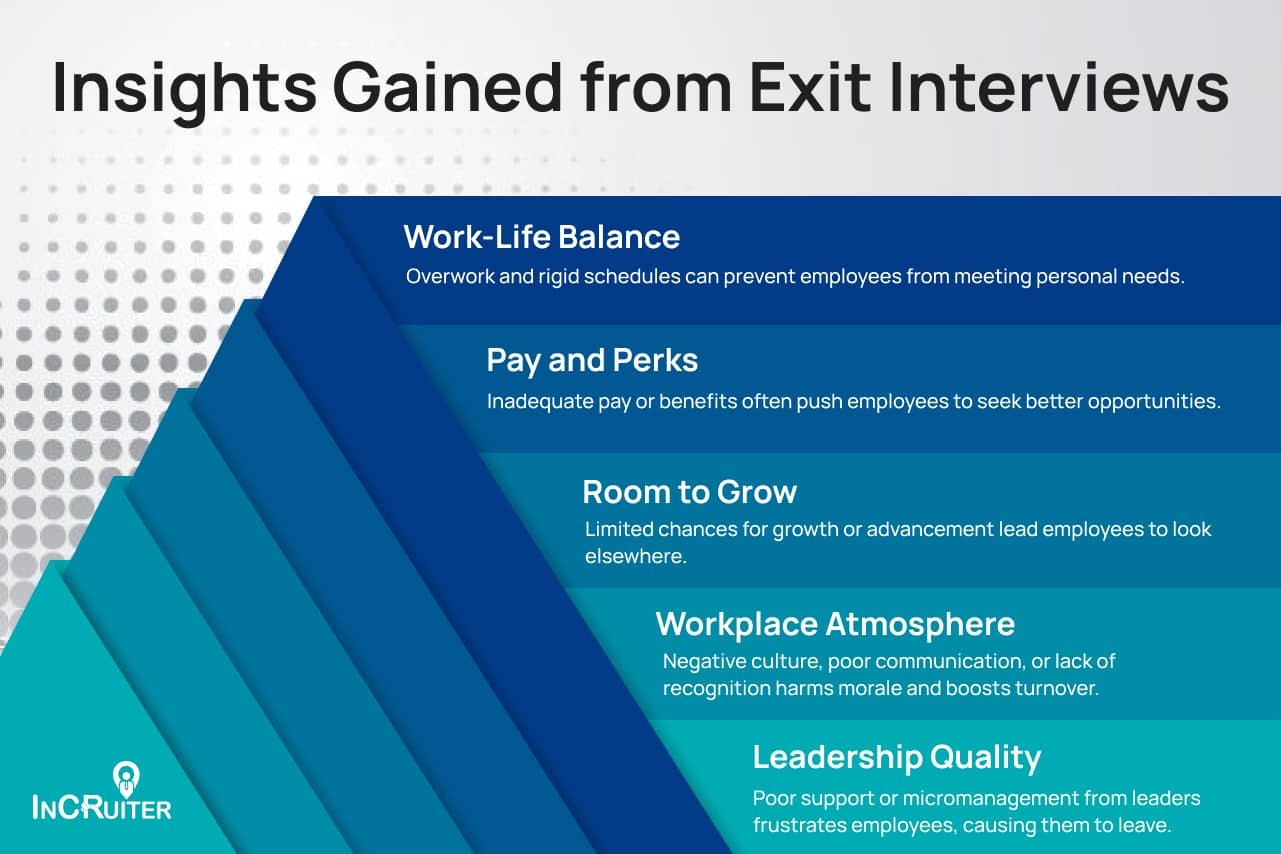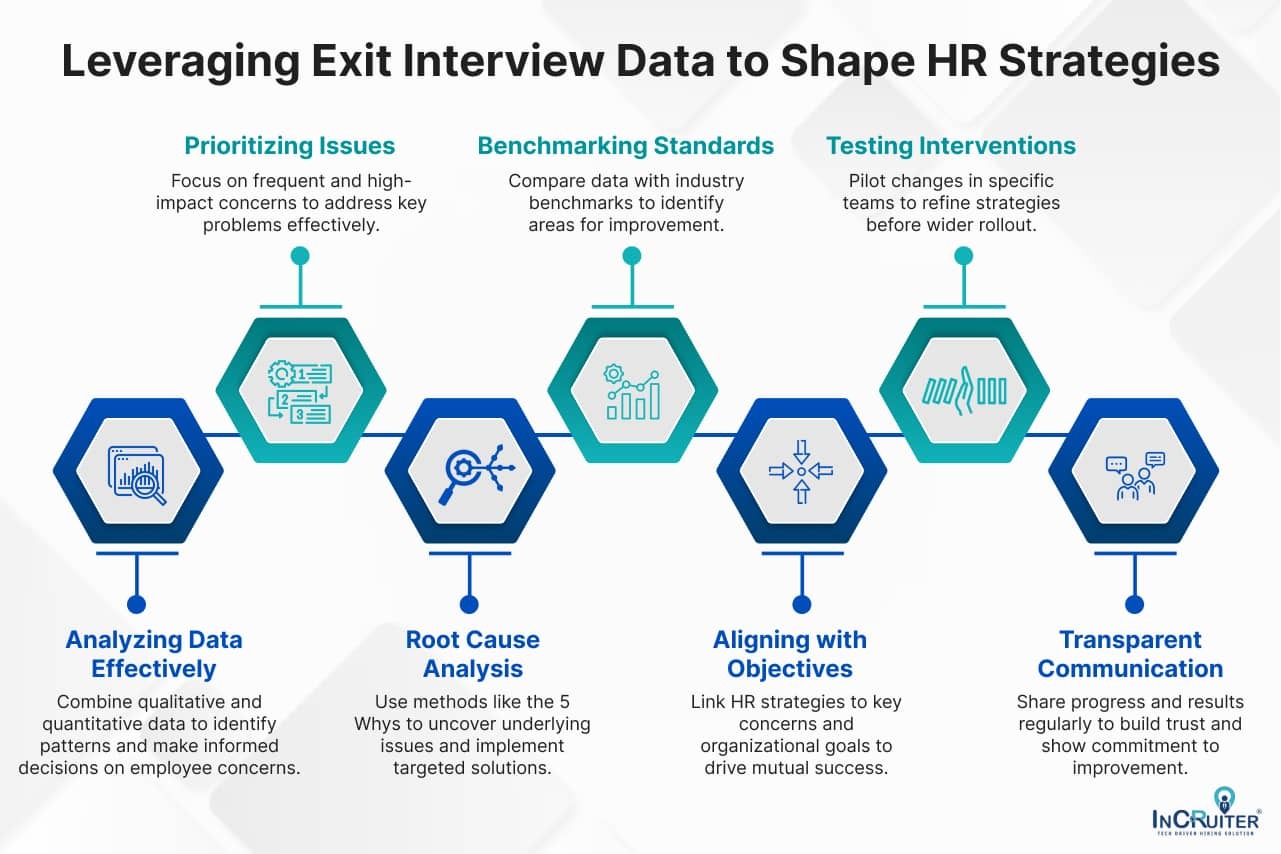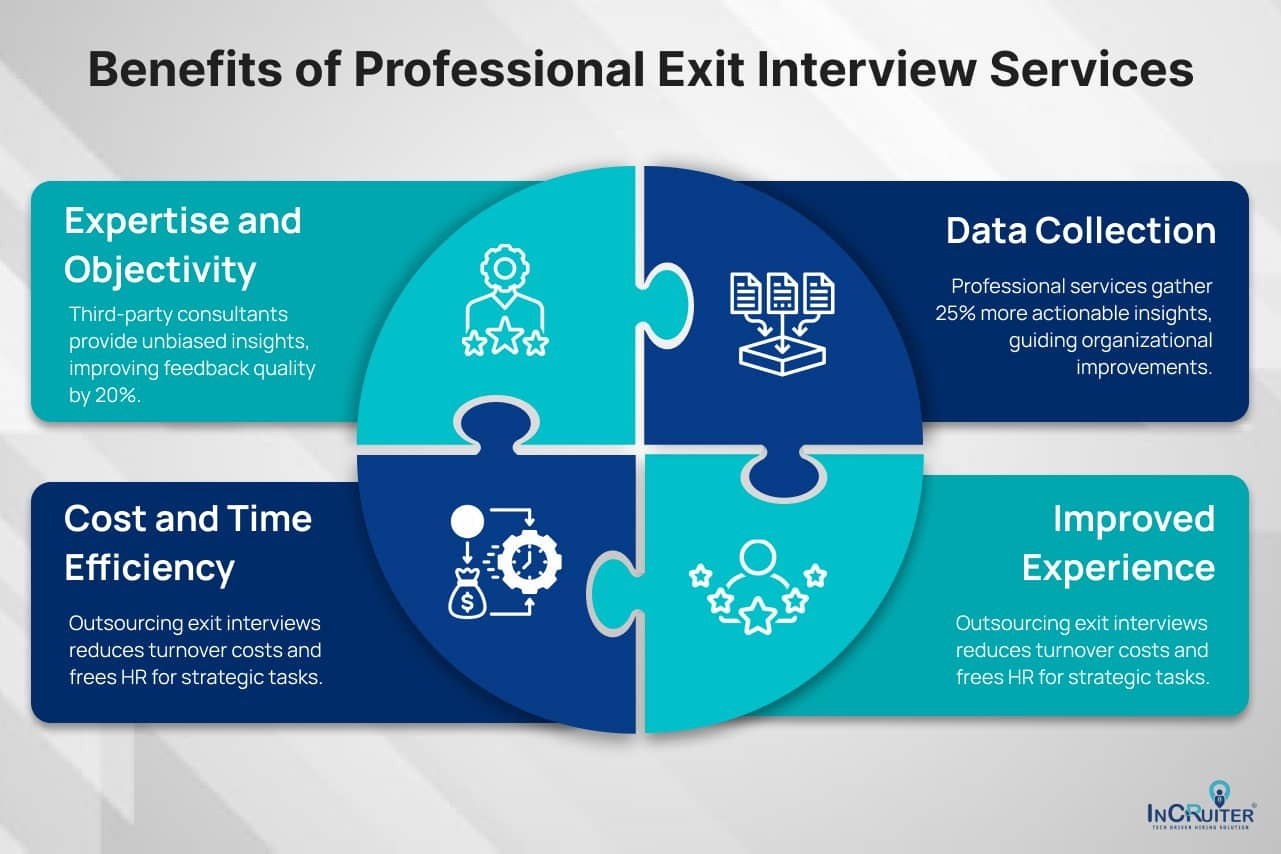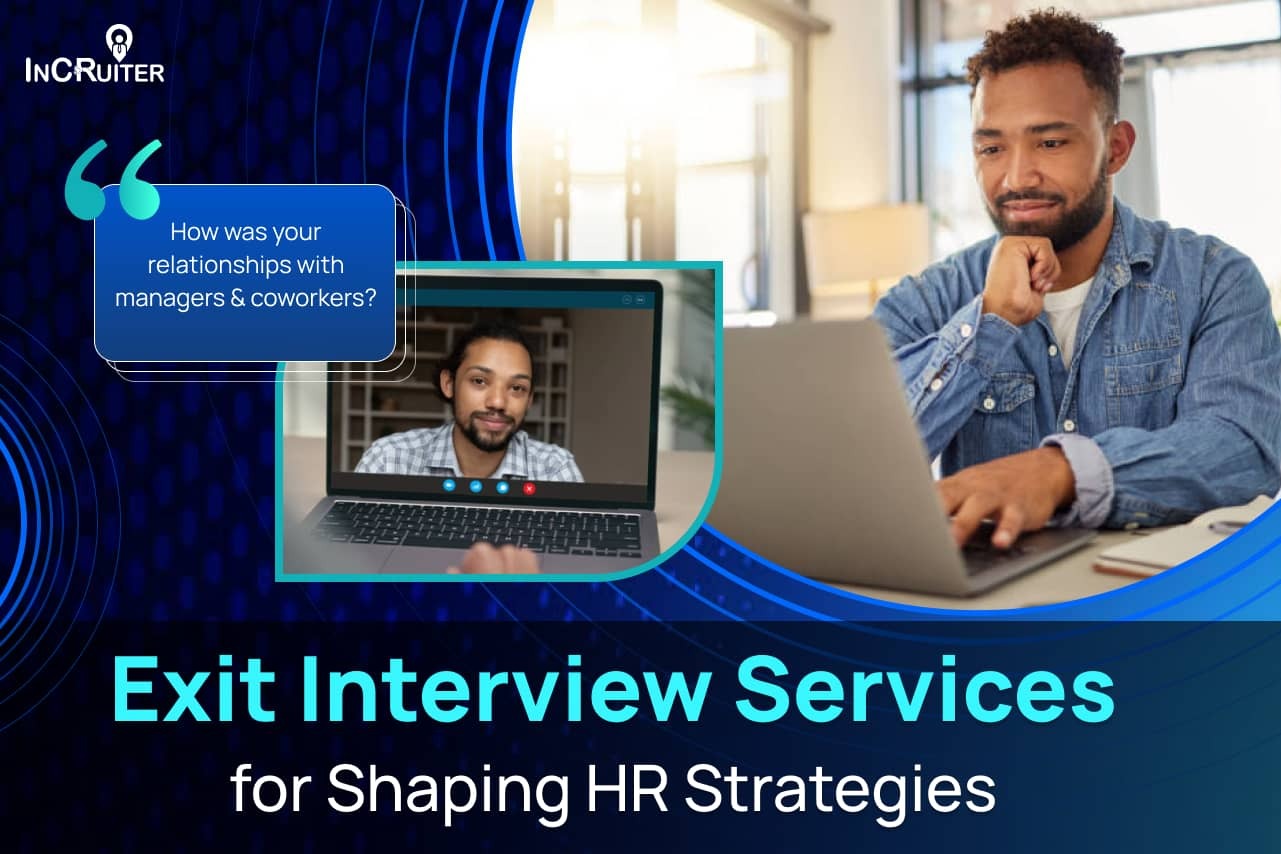The exit interview is an important constraint of human resource strategies, delivering vital information to businesses about why employees leave and what measures can be taken to boost the morale of employees. By engaging employees in meaningful conversations who are about to leave, companies get important insights.
These discussions or interviews involve several questions asking about their experience and company culture, which allows organizations to learn what might cause employees to quit their jobs and further use this information to make better strategies for the company's future to move forward. This blog focuses on the importance of exit interviews, the data uncovered from these interviews, and how the organization can use this data to make effective HR strategies.
These discussions or interviews involve several questions asking about their experience and company culture, which allows organizations to learn what might cause employees to quit their jobs and further use this information to make better strategies for the company's future to move forward. This blog focuses on the importance of exit interviews, the data uncovered from these interviews, and how the organization can use this data to make effective HR strategies.
Table Of Content
What are Exit Interviews?
An exit interview is a structured discussion between the company and an employee. The purpose is to find out the reasons behind their decision and gather their thoughts on how things worked while they were part of the company. These interviews happen in various formats, such as face-to-face, through video calls, or by survey. Usually, this interview is conducted on final day of an employee's employment with the company. The feedback or insight collected from these types of interviews can be used to make improvements in management practices, work culture and ultimately retention strategies.Why Exit Interviews Matter?
One study says nearly 52% of workers choose to leave their jobs because they are unsatisfied with the company management or how they are treated in the workplace environment. Exit interviews give these employees a fair chance to speak up and share their reasons for leaving their jobs. This interview can bring up problems that might otherwise stay under the radar. By listening to this feedback, companies can figure out what needs to be done to keep their employees satisfied and motivated.Losing employees can be expensive for any company. In fact, replacing them can cost up to 33% of a worker’s yearly salary. So, discovering the reason why employees leave their jobs is key to cutting those costs. When companies wisely utilize the exit interview data to improve organizational retention strategies, they can lower the number of people quitting by up to 20%. Plus, these interviews give companies a better understanding of how their culture, leadership, and overall employee happiness stack up.
Insights Gained from Exit Interviews

The information from exit interviews touches on a variety of important topics. Here are a few common reasons people share for leaving:
- Balance Between Work and Life: Many employees feel the weight of too much work or struggle with rigid schedules that don’t allow them to meet personal needs.
- Pay and Perks: Sometimes, employees feel they aren’t getting paid fairly or that the benefits aren’t enough to meet their needs. This can push them to look elsewhere.
- Room to Grow: A lack of chances to grow, learn new skills, or move up in the company can drive people to find new opportunities elsewhere.
- Workplace Atmosphere: If the company’s environment feels negative, communication is poor, or recognition is lacking, employee morale drops and turnover increases.
- Leadership Quality: When leaders don’t offer enough support, manage poorly, or micromanage, it can create frustration that leads to employees leaving.
Leveraging Exit Interview Data to Shape HR Strategies

Analyzing Qualitative and Quantitative Data
To make the most of exit interviews, it’s important to gather both qualitative and quantitative types of information. You’ve got the qualitative data—things like ratings or measurable data. But just as important are the stories that explain those numbers. By asking open-ended questions, you let people share their personal experiences, reasons for leaving, and feelings. These insights can often uncover details that wouldn’t be obvious if you only looked at the numbers alone. It offers nuanced feedback about the workplace environment and leadership dynamics. Conversely, quantitative data—such as job satisfaction scores, tenure lengths, and attrition rates—reveals macro trends and patterns across the workforce. By applying thematic analysis and statistical methods, HR teams can prioritize issues not only by how often they occur but also by their potential to impact retention and productivity. This dual approach ensures that interventions are both data-driven and contextually relevant.Prioritizing Issues Based on Frequency and Impact
When dissecting exit interview data, the key is not just to tally up recurring complaints but to weigh these issues based on their effect on the organization. High-frequency concerns, like dissatisfaction with compensation, may indicate a systemic problem affecting morale and turnover. On the other hand, less frequent but high-impact issues, such as toxic leadership in a critical team, could present a severe risk if left unaddressed. By striking this balance, HR can focus on solutions that target both the most widespread and the most damaging problems, aligning their efforts with broader retention strategies.Conducting Root Cause Analysis
Addressing turnover at its core involves more than acknowledging surface-level issues; it requires deep analysis to uncover the root causes. Techniques like the 5 Whys or fishbone diagrams are powerful tools for this. These methods help HR trace dissatisfaction—whether it’s burnout from poor work-life balance or disillusionment with management practices—to their true origin. For example, repeated complaints about workload might reveal underlying inefficiencies or misaligned performance expectations. Through root cause analysis, HR can formulate interventions that address these foundational issues, such as revising workload distribution or enhancing managerial support.Benchmarking Against Industry Standards
To ensure that HR strategies are competitive, benchmarking exit interview data against industry standards is critical. This comparative analysis offers a reality check, revealing areas where the organization may be lagging behind competitors or excelling. For instance, if compensation dissatisfaction is a recurring theme, benchmarking can provide insights into industry salary trends, guiding appropriate adjustments. Alternatively, if the company scores high on employee development but struggles with work-life balance, targeted initiatives can address weaknesses without losing sight of the areas in which the company already excels.Aligning Changes with Business Objectives
Aligning HR interventions with organizational goals amplifies the impact of changes based on exit interview data. For example, if exit interviews highlight that top talent is leaving due to work-life imbalance, addressing this concern becomes not just an HR priority but a strategic business imperative. Tailored solutions—whether they involve flexible scheduling, increased support for remote work, or improved time management practices—ensure that retention efforts are driving broader company success. This alignment fosters a culture where employee satisfaction and business performance reinforce each other, helping to retain key talent while advancing strategic objectives.Piloting and Testing Interventions
Instead of rolling out big changes everywhere all at once, HR should first try out new ideas with targeted departments or teams. This phased approach allows for controlled experimentation and the ability to fine-tune strategies based on real-time feedback. For instance, if workload adjustments are being tested, HR can monitor changes in team performance and satisfaction before expanding the initiative company-wide. This method minimizes risks while maximizing the chance for sustainable success, ensuring that interventions are both practical and scalable.Communicating Progress and Outcomes
Clear, transparent communication about the progress and outcomes of HR initiatives ensures accountability and fosters trust. Regularly updating leadership and employees on improvements made in response to exit interview data helps maintain momentum and demonstrates the organization’s commitment to continuous improvement. Sharing tangible results—such as a reduction in turnover or increased employee engagement scores—reinforces the importance of these efforts and strengthens the case for ongoing investment in data-driven HR strategies.Benefits of Professional Exit Interview Services

Expertise and Objectivity
Bringing specialized consultants for exit interview services offers something valuable: specialized knowledge and unbiased perspective to the interviews. According to a survey by the Society for Human Resource Management (SHRM), companies that turn to third-party exit interview companies services for exit interviews see a 20% increase in the quality of insights. Why? Because when employees know they're speaking to someone outside the company, they feel free and they provide more natural feedback about the company. People are less afraid to share their honest opinions when there is no concern about consequences.Data Collection and Analysis
Exit interview service provider often come equipped with advanced tools and methods for collecting and analyzing data. In fact, a study by Harvard Business Review showed that companies using a professional exit interview services are likely to collect 25% more actionable insights compare to those companies who depend on in-house exit interviews. It gives organizations a clear idea of where things can be improved, whether it’s in the office culture or how to retain employees longer.Cost-Effectiveness and Time-Saving
Leveraging professional interviewers to handle exit interviews allows HR teams to focus on another important tasks like preparing strategies to improve the company management based on employees' feedback. When an employee leaves their job, for the company to replace them can be quite expensive—sometimes costing up to double their yearly salary, according to a Deloitte study. But there’s a way to help reduce this cost. By having experts handle exit interviews, businesses can gather useful information from those leaving. This information can then be used to make smarter choices, which could lower the number of employees who quit and make it easier to keep good workers for a longer time. Plus, since these services are efficient, it saves time for both HR and those leaving the company.Enhanced Employee Experience
When someone leaves a job, they may hold back if talking to an internal team member. But when talking to outside interviewers, employees are more likely to share negative feedback, as found in another Harvard Business Review study. This level of honesty gives companies a chance to address problems head-on. It also shows that the company cares about its workers, even as they’re on their way out.Choosing the Right Exit Interview Service Provider
When it's time to choose an exit interview service provider for conducting exit interviews, there are a few factors to keep in mind:- Industry Experience: It's important to find a provider who knows your field or sector well and understands the specific challenges you face.
- Technological Capabilities: Check if the provider uses advanced technology to gather and make sense of data. The better the tools, the better the insights you’ll receive.
- Customization Options: You want a service that can be shaped to fit your company’s exact needs, not a one-size-fits-all approach.
The Future of Interviewing
The use of smart technology like artificial intelligence and automation in exit interviews is changing the way businesses collect and study employee feedback. A tech solution like AI can spot trends in large sets of data, helping HR teams make decisions faster and more accurately based on data. As more companies turn to online exit interviews, a shift that sped up during the COVID pandemic, new problems and possibilities have come into play.Remote interviews are easier to set up but need extra attention to build trust and keep things real. New tech also makes it possible to predict future trends by looking at past data from exit interviews. This helps businesses plan ahead and tackle issues before they become big problems. With all these changes, exit interviews are now a key part of improving how companies keep their employees happy and engaged.
Conclusion
When people leave a job, it’s an important moment for companies to learn and grow. A lot of large businesses, like 96% of Fortune 500 companies, use these exit conversations to get valuable insights. By paying attention to what these workers say, companies can make changes that keep others satisfied, improve the work culture, and even save money by keeping staff longer. This process helps businesses see what’s working well and what needs fixing, leading to a better workplace for everyone.Investing in professional exit interview vendor services ensures that companies receive high-quality insights, which can drive meaningful organizational improvements. Organizations should prioritize exit interviews as a strategic tool for growth and long-term success.
Companies are encouraged to explore professional exit interview services to better understand employee experiences and foster a culture of continuous improvement. By taking proactive steps, organizations can position themselves for long-term success.
.png)
#1 for Interview as a Service Platform
We blend technology and human expertise to find the perfect fit for your organization. We have a dedicated pool of 3000+ freelance interviewers to ensure fair evaluations.
Frequently Asked Questions
Got a question? We’re here to answer!
How can exit interview services improve employee retention?

Exit interview services improve employee retention by identifying the underlying reasons why employees leave. By systematically gathering and analyzing feedback, organizations can pinpoint areas needing improvement, such as management practices, workplace culture, or career development opportunities. Implementing changes based on these insights can lead to a more engaged workforce, reducing turnover rates. According to studies, companies that actively utilize exit interview data can decrease turnover by up to 20%, demonstrating the significant impact of these services on retention.
Are exit interview services only useful for large companies?

Exit interview services are beneficial for organizations of all sizes. While large companies often have more resources to implement structured exit interview processes, small and medium-sized enterprises can also gain valuable insights from understanding why employees leave. These insights can help smaller organizations improve their workplace culture and retention strategies, making exit interviews a valuable tool regardless of company size.
How do exit interview services ensure data confidentiality?

Exit interview services ensure data confidentiality by implementing strict protocols for handling sensitive information. This includes conducting interviews anonymously or using secure survey platforms that do not link feedback to individual employees. Additionally, HR professionals involved in the process are trained to manage confidential information discreetly. By fostering an environment of trust, organizations can encourage departing employees to share honest feedback without fear of repercussions.
What are the key metrics for measuring the success of exit interviews?

Key metrics for measuring the success of exit interviews include response rates, the quality of insights generated, and subsequent changes in employee retention rates. Organizations can also track specific themes or issues raised during interviews and assess whether implemented changes lead to improvements in workplace satisfaction. Monitoring these metrics over time allows HR to evaluate the effectiveness of their exit interview processes and make necessary adjustments.
How frequently should exit interviews be conducted?

Exit interviews should ideally be conducted for every departing employee, regardless of the circumstances surrounding their departure. This approach ensures that organizations gather comprehensive data on employee experiences. While it is essential to conduct exit interviews consistently, the timing can vary; they are typically scheduled during the employee's last week of work to capture their experiences while still fresh in their minds.


 0
0
 Shares 636
Shares 636 Shares 636
Shares 636 Shares 636
Shares 636






